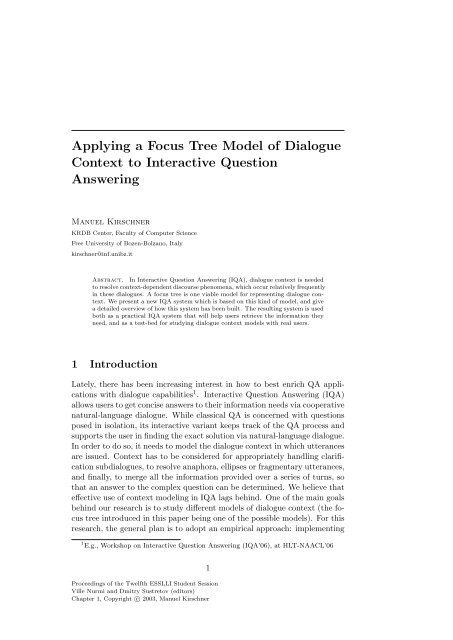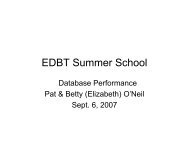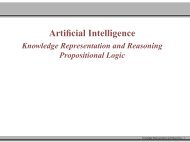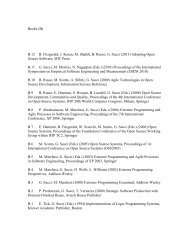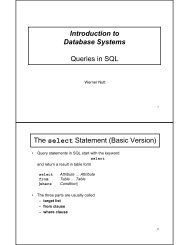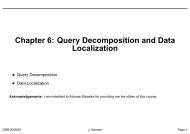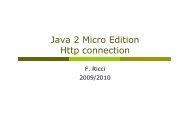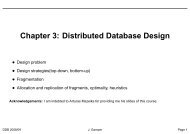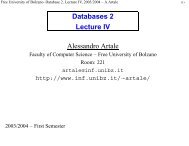Applying a Focus Tree Model of Dialogue - Faculty of Computer ...
Applying a Focus Tree Model of Dialogue - Faculty of Computer ...
Applying a Focus Tree Model of Dialogue - Faculty of Computer ...
You also want an ePaper? Increase the reach of your titles
YUMPU automatically turns print PDFs into web optimized ePapers that Google loves.
<strong>Applying</strong> a <strong>Focus</strong> <strong>Tree</strong> <strong>Model</strong> <strong>of</strong> <strong>Dialogue</strong><br />
Context to Interactive Question<br />
Answering<br />
Manuel Kirschner<br />
KRDB Center, <strong>Faculty</strong> <strong>of</strong> <strong>Computer</strong> Science<br />
Free University <strong>of</strong> Bozen-Bolzano, Italy<br />
kirschner@inf.unibz.it<br />
Abstract. In Interactive Question Answering (IQA), dialogue context is needed<br />
to resolve context-dependent discourse phenomena, which occur relatively frequently<br />
in these dialogues. A focus tree is one viable model for representing dialogue context.<br />
We present a new IQA system which is based on this kind <strong>of</strong> model, and give<br />
a detailed overview <strong>of</strong> how this system has been built. The resulting system is used<br />
both as a practical IQA system that will help users retrieve the information they<br />
need, and as a test-bed for studying dialogue context models with real users.<br />
1 Introduction<br />
Lately, there has been increasing interest in how to best enrich QA applications<br />
with dialogue capabilities 1 . Interactive Question Answering (IQA)<br />
allows users to get concise answers to their information needs via cooperative<br />
natural-language dialogue. While classical QA is concerned with questions<br />
posed in isolation, its interactive variant keeps track <strong>of</strong> the QA process and<br />
supports the user in finding the exact solution via natural-language dialogue.<br />
In order to do so, it needs to model the dialogue context in which utterances<br />
are issued. Context has to be considered for appropriately handling clarification<br />
subdialogues, to resolve anaphora, ellipses or fragmentary utterances,<br />
and finally, to merge all the information provided over a series <strong>of</strong> turns, so<br />
that an answer to the complex question can be determined. We believe that<br />
effective use <strong>of</strong> context modeling in IQA lags behind. One <strong>of</strong> the main goals<br />
behind our research is to study different models <strong>of</strong> dialogue context (the focus<br />
tree introduced in this paper being one <strong>of</strong> the possible models). For this<br />
research, the general plan is to adopt an empirical approach: implementing<br />
1 E.g., Workshop on Interactive Question Answering (IQA’06), at HLT-NAACL’06<br />
Proceedings <strong>of</strong> the Twelfth ESSLLI Student Session<br />
Ville Nurmi and Dmitry Sustretov (editors)<br />
Chapter 1, Copyright c○ 2003, Manuel Kirschner<br />
1
<strong>Applying</strong> a <strong>Focus</strong> <strong>Tree</strong> <strong>Model</strong> <strong>of</strong> <strong>Dialogue</strong> Context to Interactive Question Answering<br />
different models in a practical IQA system, and then validating them with<br />
real user data.<br />
<strong>Dialogue</strong> context is needed to resolve context-dependent discourse phenomena<br />
that occur in dialogues. These phenomena typically include pronouns<br />
and anaphoric noun phrases, elided phrases (missing semantic arguments),<br />
and fragments. In the course <strong>of</strong> a series <strong>of</strong> user utterances within an<br />
IQA session, each <strong>of</strong> these phenomena establishes some kind <strong>of</strong> dependency<br />
between the single utterances. We conducted a Wizard-<strong>of</strong>-Oz study with<br />
librarians <strong>of</strong> the university library and actual library users (cf. Kirschner<br />
(2006) for the experimental setup). One <strong>of</strong> the goals <strong>of</strong> this study was<br />
to analyze discourse phenomena occurring in actual user log files. Of the<br />
initially collected dialogues, around one quarter exhibited some kind <strong>of</strong> discourse<br />
phenomenon. Albeit on the lower end, this ratio is still within the<br />
spectrum reported in the literature. Conversation log files <strong>of</strong> informationseeking<br />
tasks in particular have been reported to contain the lowest share <strong>of</strong><br />
context-dependent turns (Dahlbäck and Jönsson (1989), in Bertomeu et al.<br />
(2006)). Interpreting our experimental results, we believe that studying<br />
models <strong>of</strong> dialogue context is worthwhile both from a theoretical point <strong>of</strong><br />
view, as well as with respect to the practical IQA system that will be described<br />
later in this paper.<br />
This paper is structured as follows. In section 2, we introduce the notion<br />
<strong>of</strong> dialogue context, and explain the concept <strong>of</strong> focus trees. We also provide<br />
an overview <strong>of</strong> some relevant literature. Section 3 explains the background<br />
and general design principles <strong>of</strong> the IQA system that we are developing.<br />
Finally, in section 4, we present the implementation in detail.<br />
2 <strong>Model</strong>ing dialogue context: Previous work<br />
In order to correctly interpret every user utterance from a series, an IQA system<br />
needs a model <strong>of</strong> dialogue context that incorporates context-dependent<br />
discourse phenomena. More generally, for every new user utterance, the<br />
dialogue context model should correctly predict whether the topic <strong>of</strong> the interaction<br />
has stayed the same or switched to something new (possibly related<br />
in a specific way to the previous topic). De Boni and Manandhar (2005)<br />
and Yang et al. (2006) describe two approaches to recognizing whether the<br />
topic has changed between two subsequent user utterances. In both cases,<br />
the decision is based on a set <strong>of</strong> linguistic features extracted from the utterances;<br />
the features are then combined in decision algorithms using heuristics<br />
or supervised machine learning, respectively.<br />
While these approaches are effective in terms <strong>of</strong> detecting topic changes,<br />
they do not attempt to model the patterns <strong>of</strong> topic change. As for these<br />
patterns, Bertomeu et al. (2006) provide an empirical study <strong>of</strong> thematic relations<br />
holding between user questions and the preceding context, and <strong>of</strong><br />
2
Manuel Kirschner<br />
the location <strong>of</strong> antecedents between user utterances in IQA dialogues. Different<br />
architectures and dialogue theories have been proposed for modeling<br />
dialogue context, and to explain certain patterns <strong>of</strong> topic change. What<br />
follows is a review <strong>of</strong> how focus trees have been used in this respect.<br />
2.1 <strong>Model</strong>ing changes <strong>of</strong> dialogue topic using a focus tree<br />
A focus tree provides a way <strong>of</strong> modeling the dialogue context that can account<br />
for topic changes occurring in the course <strong>of</strong> a dialogue. The main<br />
idea is to organize all the topics <strong>of</strong> the IQA system’s task domain hierarchically.<br />
The nodes <strong>of</strong> this tree represent the current conversational topic (i.e.,<br />
a concept that has already been mentioned in the on-going dialogue and<br />
that is currently in the focus <strong>of</strong> the dialogue participants). Representing the<br />
current topic via a specific node in the tree is based on the following notion:<br />
topic shifts to a somehow “related” topic are more likely than jumping to<br />
unrelated ones. In a focus tree, relatedness can be modeled via structural<br />
relations between nodes <strong>of</strong> the tree.<br />
Several different ways <strong>of</strong> designing such trees have been mentioned in<br />
the literature (generally without giving a formulation <strong>of</strong> some rigorous algorithm).<br />
The applications for which focus trees have been employed are<br />
varied. McCoy and Cheng (1991) use the tree to constrain what should<br />
be said next in a natural-language generation system, by representing the<br />
cognitive load <strong>of</strong> different topic shifts in the tree. Jokinen et al. (1998) start<br />
with a manually built tree for marking up main topics in task-based dialogue<br />
data, which is extended by an n-gram-based model for topic shifts.<br />
The application: predicting the next topic in a spoken dialogue system. Finally,<br />
Stede and Schlangen (2004) propose to use a focus tree (in the form <strong>of</strong><br />
a LOOM taxonomy) for dialogue management; given a user’s dialogue act,<br />
the system retrieves a reply from the taxonomy based (at least partly) on<br />
structural aspects <strong>of</strong> the tree.<br />
As in the three approaches just mentioned, the focus tree we are using<br />
in our IQA implementation (introduced in section 4) is also built entirely by<br />
hand. Thus, it relies critically on the exact way the tree was constructed.<br />
While this seems to be a more general problem with knowledge-intensive<br />
NLP systems, we hope to alleviate it in the future by defining some formal<br />
requirements for the construction <strong>of</strong> focus trees. Another way <strong>of</strong> avoiding<br />
the uncertainty <strong>of</strong> building focus trees by hand is to try to learn them from<br />
data. To point to one data-driven alternative: Niwa et al. (1997) learn<br />
certain relations between topics from free text. However, in our case, the<br />
lack <strong>of</strong> large amounts <strong>of</strong> training data prevents us from using such datadriven<br />
approaches.<br />
3
<strong>Applying</strong> a <strong>Focus</strong> <strong>Tree</strong> <strong>Model</strong> <strong>of</strong> <strong>Dialogue</strong> Context to Interactive Question Answering<br />
2.2 Extended system interactivity by exploiting the dialogue<br />
context model<br />
Besides the question <strong>of</strong> how to best model the dialogue context, another interesting<br />
issue for research has been the role <strong>of</strong> dialogue management in IQA.<br />
Here, we are concerned with the general dialogue strategy that the system<br />
should adhere to in a conversation (see Core et al. (2003) for a comparison<br />
<strong>of</strong> dialogue strategies in the context <strong>of</strong> tutorial dialogue). More specifically,<br />
one should identify the most helpful system responses at any point in the<br />
IQA dialogue. For example, Varges et al. (2006) describe a system that can<br />
modify the constraints <strong>of</strong> a user query by engaging in clarification subdialogues.<br />
A further goal <strong>of</strong> extended system interactivity could be to let the<br />
system actively guide the user through the information seeking process.<br />
It is an open question whether an IQA system can provide certain types<br />
<strong>of</strong> extended interactivity by exploiting its model <strong>of</strong> dialogue context. The<br />
underlying notion is to use the dialogue context as a source for supporting<br />
(meta) knowledge that can be communicated to the user via system initiated<br />
turns. Thus, the system would not only answer user questions from<br />
within the task domain using the structured knowledge source, but also<br />
implicit knowledge extracted directly from the current state <strong>of</strong> the context<br />
model. The idea is that the user might benefit from viewing some version <strong>of</strong><br />
contextual information that is normally not visible to him. An interesting<br />
starting point in this direction is provided by Chai and Jin (2004). As an<br />
IQA dialogue evolves and grows longer, they build up rich contextual information<br />
in the form <strong>of</strong> a directed acyclic graph that encodes the discourse<br />
roles and discourse relations introduced so far; they conjecture that these<br />
graphs could be used also as a basis for collaborative QA.<br />
3 Proposed approach<br />
For our study <strong>of</strong> dialogue context in IQA, we have been adopting a bottomup<br />
approach: we start by implementing a baseline system that, while still<br />
being rather simplistic regarding the underlying theories, works robustly for<br />
a large proportion <strong>of</strong> the use cases. Talking about a practical IQA system,<br />
we start with a shallow Natural Language Understanding component<br />
(namely regular expression pattern matching) to map from user queries to<br />
system responses. Our initial model for dialogue context is a focus tree,<br />
which provides a simple way <strong>of</strong> keeping the dialogue state between two user<br />
turns. The type <strong>of</strong> interaction in our baseline IQA system is limited to a<br />
user-initiated stimulus-response loop, i.e., there is no system initiative yet,<br />
but the system simply returns one fixed response for every user utterance it<br />
receives. As soon as this system will be running, we propose to start collecting<br />
real data (from user interactions). Under the bottom-up paradigm, we<br />
expect to gain insights from the analysis <strong>of</strong> the data, especially regarding<br />
4
Manuel Kirschner<br />
communication problems that will occur. This analysis will guide us as to<br />
which aspect <strong>of</strong> our current system should be fixed or improved first. We<br />
have started implementing these principles for designing a practical IQA<br />
system as a case study, which we now introduce.<br />
3.1 Case study<br />
Our university library is striving to improve their on-line information services.<br />
An IQA system provides permanent and instant access to libraryspecific<br />
information. As the experiences <strong>of</strong> other libraries have shown, such<br />
systems can surpass static information resources like FAQ lists in that they<br />
guide users towards a solution when initially they did not know the exact<br />
question.<br />
Together with a team <strong>of</strong> librarians, we have started building a practical<br />
IQA system (BoB: the Bolzano library Bot). This project serves as a<br />
case study for implementing theories <strong>of</strong> dialogue context in IQA, and for<br />
validating them with real user data. As our research project (and our implementation<br />
<strong>of</strong> BoB) evolves, the library will have at their disposal an increasingly<br />
powerful IQA system. One <strong>of</strong> the long-term goals <strong>of</strong> the project is<br />
to support information seeking dialogues in three languages (English, Italian<br />
and German). See Kirschner (2007) for an overview <strong>of</strong> dedicated s<strong>of</strong>tware<br />
tools that the librarians and domain experts use for the administration and<br />
translation <strong>of</strong> BoB’s knowledge base from German into the other two target<br />
languages.<br />
4 Implementation <strong>of</strong> a practical IQA system<br />
We will now describe some results in terms <strong>of</strong> the current implementation <strong>of</strong><br />
BoB. We start by showing how we built the focus tree from hand-coded data<br />
that we imported from another system. We then elaborate on the current<br />
implementation <strong>of</strong> BoB, describing in detail how it uses the library domain<br />
focus tree to yield a baseline IQA system.<br />
4.1 A focus tree for the library domain<br />
Through a cooperation with the library <strong>of</strong> the University <strong>of</strong> Hamburg, we<br />
acquired the library domain knowledge base 2 <strong>of</strong> Stella, a “chatterbot” (simple<br />
text-based dialogue system) implementation based on proprietary code.<br />
We planned to use these data for two purposes: to jump-start the creation<br />
<strong>of</strong> a focus tree for our own university library domain, and to extract and<br />
re-use as much as possible <strong>of</strong> the information that has been encoded by a<br />
team <strong>of</strong> librarians in Hamburg over several years.<br />
2 Note that the term “knowledge base” is used informally here; it refers to a hierarchy<br />
<strong>of</strong> library topics whose structure is not formalized.<br />
5
<strong>Applying</strong> a <strong>Focus</strong> <strong>Tree</strong> <strong>Model</strong> <strong>of</strong> <strong>Dialogue</strong> Context to Interactive Question Answering<br />
With respect to jump-starting the creation <strong>of</strong> our own focus tree, we<br />
considered the Hamburg data to be interesting because <strong>of</strong> the following<br />
properties. Firstly, the application domain is very similar to ours: both<br />
Hamburg’s chatterbot and our proposed IQA system provide a wide array<br />
<strong>of</strong> support to the users <strong>of</strong> a university library. Also, their knowledge base has<br />
been created, extended and fine-tuned by a team <strong>of</strong> around five librarians<br />
over several years. As a consequence, we hope that the quality and quantity<br />
<strong>of</strong> library topics encoded in the knowledge base let us build our first baseline<br />
IQA system with a good coverage <strong>of</strong> library-related questions and answers.<br />
Although we doubt that the Hamburg knowledge base will serve us directly<br />
for reaching new insights about dialogue context modeling, we do expect<br />
that from a data-driven perspective to building dialogue systems, the more<br />
data we have, the better.<br />
The Hamburg library knowledge base encodes 230 topics in a focus tree 3 .<br />
As stated above, our secondary goal for incorporating the Hamburg data<br />
was to extract and take advantage <strong>of</strong> as much hand-coded information as<br />
possible that had been entered by Hamburg’s librarians. Looking inside the<br />
230 topics, the knowledge base consists <strong>of</strong> an overall <strong>of</strong> over 2000 pairs <strong>of</strong> 1. a<br />
regular expression pattern to match some user input, and 2. a canned-text<br />
system response to be returned to the user.<br />
We do not know the exact principles with which Hamburg’s focus tree<br />
was constructed, but after looking at their knowledge base in some detail,<br />
we conjecture that their librarians mixed different principles <strong>of</strong> organizing<br />
topics into a hierarchy 4 . A detailed analysis <strong>of</strong> the data showed that, besides<br />
containing the previously mentioned regular expression patterns and system<br />
responses organized into the focus tree, they contain a host <strong>of</strong> additional<br />
information, some <strong>of</strong> which we found useful to import into our own system’s<br />
knowledge base. In the next section, we describe these additional features,<br />
as well as our current implementation <strong>of</strong> BoB, explaining in detail our focus<br />
tree search algorithm.<br />
4.2 The BoB system<br />
We have implemented BoB as a Java-based web application that will eventually<br />
be deployed on the library web site. Using the focus tree as a model<br />
for dialogue context, the system can in principle process user utterances that<br />
contain certain discourse phenomena (i.e., the above mentioned fragments,<br />
ellipses and anaphora). What follows is a description <strong>of</strong> the underlying no-<br />
3 At the highest level <strong>of</strong> the tree, there are 22 main topics, including: library buildings,<br />
organization, services, catalog query, books, journals, topics, articles, lending, inter-library<br />
loan, web site.<br />
4 E.g., based on semantically related concepts in the library domain, or related tasks<br />
that library users <strong>of</strong>ten perform, or local proximity <strong>of</strong> different concepts in a library<br />
building.<br />
6
Manuel Kirschner<br />
tion behind how BoB uses a focus tree to represent the dialogue context,<br />
and to generate a system response to a user query. Like most chatterbots<br />
in the tradition <strong>of</strong> ELIZA (Weizenbaum (1966)), our system is based on a<br />
stimulus-response loop for mapping a user utterance to some corresponding<br />
answer. All responses are stored as canned-text strings. Responding to<br />
some user query is thus a problem <strong>of</strong> identifying the best response, which<br />
is then simply output to the user. The mapping from user input to system<br />
response is done on the basis <strong>of</strong> regular expression patterns; for every system<br />
response, we have stored a regular expression pattern that matches certain<br />
types <strong>of</strong> user input.<br />
In BoB, each regular expression pattern for matching user input is stored<br />
in combination with a pre-canned system response. Unlike in most chatterbots,<br />
these pairs are organized hierarchically as nodes <strong>of</strong> a focus tree, where<br />
each node represents a specific dialogue context. In the course <strong>of</strong> a dialogue,<br />
the current topic switches between the nodes <strong>of</strong> the tree, depending<br />
on what regular expression patterns the current user utterance matches, and<br />
at which node the search for a matching regular expression pattern starts. In<br />
this simple model <strong>of</strong> dialogue history, the current focus node represents the<br />
dialogue state, i.e., it encodes all the information that is preserved between<br />
two succeeding user utterances.<br />
As mentioned above, the knowledge base we acquired from Hamburg<br />
contains a host <strong>of</strong> information that goes beyond the topic hierarchy and the<br />
regular expression patterns and canned-text answers encoded in each focus<br />
node. Some parts <strong>of</strong> this additional information seemed too idiosyncratic<br />
to re-use for the BoB system. For example, some nodes in the Hamburg<br />
focus tree contain hand-tuned weights for changing the precedence in which<br />
they are processed by the search algorithm. Since we do not know how<br />
these weights were chosen, nor how exactly the original search algorithm<br />
uses them, we did not consider them in our system. On the other hand,<br />
we do re-use two extra features encoded in Hamburg’s focus tree, namely<br />
context-dependent follow-up questions and system-initiated subdialogues.<br />
Re-using context-dependent follow-up questions<br />
One <strong>of</strong> the distinguishing features <strong>of</strong> Interactive QA is that it allows users<br />
to pose questions that are related in certain ways to the previous dialogue.<br />
We call every question in an IQA dialogue “follow-up” if there exists at<br />
least some previous user question or system response, since all follow-ups<br />
are potentially related to the dialogue context. An analysis <strong>of</strong> the kinds <strong>of</strong><br />
(thematic) relations that may hold in these situations is outside the scope <strong>of</strong><br />
this paper, but we believe it to be important to further the understanding<br />
<strong>of</strong> IQA dialogues in general, and the requirements for practical IQA systems<br />
(manuscript in preparation). At this point, we are interested only in<br />
the subset <strong>of</strong> context-dependent follow-up questions, i.e., that require some<br />
7
<strong>Applying</strong> a <strong>Focus</strong> <strong>Tree</strong> <strong>Model</strong> <strong>of</strong> <strong>Dialogue</strong> Context to Interactive Question Answering<br />
additional information from the dialogue context in order to be fully specified<br />
and unambigious. In fact, the Hamburg focus tree includes dedicated<br />
focus nodes that specifically cover context-dependent follow-up questions.<br />
These focus nodes were assigned a special “context-dependent” attribute by<br />
Hamburg’s domain experts, which is interpreted by the focus tree search algorithm<br />
in that it searches these nodes first, and only in the specific dialogue<br />
context for which the domain experts have foreseen the follow-up question.<br />
What follows is an example taken from the Hamburg focus tree (and re-used<br />
for BoB). After the user has asked about the availability <strong>of</strong> guided tours to<br />
the library, he asks an elliptical follow-up question 5 : “Where is the meeting<br />
point?”. This follow-up matches with the regular expression pattern from<br />
a focus node marked specifically as context-dependent, whose question pattern<br />
contains only “where”, but does not require “guided tour” to appear<br />
in the question.<br />
Re-using subdialogues<br />
Subdialogues are used to encode relatively short, predefined sequences <strong>of</strong><br />
system questions, to which the user’s answer must come from a small, predefined<br />
set <strong>of</strong> possible answers (e.g., “yes/no” for simple questions). From<br />
the domain expert’s point <strong>of</strong> view, they allow users to be guided through<br />
the domain by pointing them to relevant options in specific dialogue situations.<br />
This kind <strong>of</strong> guidance should be especially useful for inexperienced<br />
users who do not know how to formulate their problem or question explicitly.<br />
Subdialogues must be handled explicitly by the search algorithm, since their<br />
regular expression patterns must only be searched when the corresponding<br />
subdialogue is active. This prevents focus nodes with unspecific patterns<br />
like “yes” to be selected in the course <strong>of</strong> the global focus tree search (steps<br />
3 and 4 <strong>of</strong> the algorithm described at the end <strong>of</strong> this section).<br />
The decision in favor <strong>of</strong> importing the pre-defined subdialogues comes<br />
at a cost. The way that subdialogues are included in the focus tree using a<br />
special type <strong>of</strong> focus nodes breaks the otherwise clean and purely declarative<br />
nature <strong>of</strong> the tree structure. Besides encoding topics and sub-topics, the tree<br />
now contains nodes with procedural semantics, which require the focus tree<br />
search algorithm to follow a hard-coded link to some other (possibly remote)<br />
node, where the next user turn can then be processed as a continuation <strong>of</strong><br />
the subdialogue. One solution for separating the declarative topic hierarchy<br />
from these procedural additions would be to have a more powerful dialogue<br />
manager that could generate subdialogue sequences on the fly, given information<br />
about the current topic. It would be a possible step towards a better<br />
understanding and control <strong>of</strong> system initiative in an IQA system.<br />
5 In the surface form, the follow-up question is lacking the attribute “. . . for guided<br />
tours?”.<br />
8
Searching the focus tree<br />
Manuel Kirschner<br />
We now describe the current implementation <strong>of</strong> BoB’s search algorithm, and<br />
how it works in conjunction with the focus tree introduced earlier in this<br />
section. Every time the user enters a new question, a suitable node in the<br />
focus tree has to be identified, so that the system response stored in that<br />
specific topic node can be returned as an answer. The search for a focus<br />
node depends both on the user input and on the previously active focus<br />
node. By starting each search for the next system response at the currently<br />
active focus node, we take advantage <strong>of</strong> idea that topics which describe likely<br />
continuations <strong>of</strong> the conversation should have been placed closer (in terms<br />
<strong>of</strong> node distance) to each other in the tree. Figure 1.1 shows a flow chart <strong>of</strong><br />
the focus tree search algorithm as it is currently implemented in BoB. For<br />
compactness <strong>of</strong> the diagram, the following notation is used:<br />
C the Current focus node<br />
SD a Sub<strong>Dialogue</strong> focus node<br />
CD a Context-Dependent focus node<br />
N a “normal” focus node (i.e., neither SD nor CD)<br />
Match specific focus node retrieved by previous search operation<br />
.link link attribute <strong>of</strong> SD, pointing to specific focus node where<br />
subdialogue processing will resume<br />
.sysResponse system response encoded in focus node<br />
SD-Mode flag indicating if system is currently in a subdialogue<br />
“matching” focus node’s regular expression pattern matches current<br />
user input<br />
Conceptually, the search algorithm can be divided into two parts. In the<br />
first part (consisting <strong>of</strong> the pattern matching steps marked with (1) and (2)<br />
in the diagram), subdialogues and context-dependent follow-up questions are<br />
dealt with on a local level, i.e., without the current focus shifting to a node<br />
more remote than the sibling nodes. In the second part <strong>of</strong> the algorithm<br />
(pattern matching steps marked with (3) and (4)), the search space for a<br />
system response is gradually extended to the entire focus tree.<br />
5 Conclusion and future directions<br />
Currently, the contents and the topology <strong>of</strong> the focus tree are determined<br />
entirely by domain experts based on their intuition. We are currently exploring<br />
systematic ways <strong>of</strong> constructing or extending a focus tree, so as to<br />
get an understanding <strong>of</strong> which (follow-up) user questions will be covered<br />
by the system (manuscript in preparation). What we clearly lack at this<br />
point is an evaluation <strong>of</strong> the BoB system with respect to real user data.<br />
We are considering different possibilities for this. Regarding BoB’s coverage<br />
9
<strong>Applying</strong> a <strong>Focus</strong> <strong>Tree</strong> <strong>Model</strong> <strong>of</strong> <strong>Dialogue</strong> Context to Interactive Question Answering<br />
SD-Mode = true<br />
SD-Mode = false<br />
Fail: no answer<br />
found in tree<br />
[C == root node]<br />
(1) Match = search siblings<br />
<strong>of</strong> C for matching SD<br />
[No match] [Match]<br />
C = parent <strong>of</strong> C<br />
[C.link exists]<br />
C = root node<br />
SD-Mode = false<br />
Wait for user question<br />
[SD-Mode == true]<br />
answer Match.sysResponse<br />
C = Match.link<br />
[C != root node]<br />
[no C.link exists]<br />
[SD-Mode == false]<br />
(2) Match = search C and<br />
siblings <strong>of</strong> C for matching CD<br />
(3) Match = search C and<br />
siblings <strong>of</strong> C for matching N<br />
[No match]<br />
[Match]<br />
[No match]<br />
(4) Match = breadth-first search descendents<br />
<strong>of</strong> C and <strong>of</strong> siblings <strong>of</strong> C for matching N<br />
[No match] [Match]<br />
Figure 1.1: The BoB focus tree search algorithm<br />
10<br />
[Match]<br />
answer Match.sysResponse<br />
C = Match
Manuel Kirschner<br />
<strong>of</strong> the most important topics <strong>of</strong> user questions, we have only a preliminary<br />
result based on the not yet “localized” Hamburg focus tree (cf. Kirschner<br />
(2006)). A more thorough user study can be conducted once the focus tree<br />
has been completely adjusted by our domain experts (see below). This user<br />
study will also have to verify the ability <strong>of</strong> the system to handle contextdependent<br />
follow-up questions via the special “CD” focus nodes described<br />
earlier. We are currently studying how well our focus tree-based approach is<br />
able to model (context-dependent) follow-up user questions, using our previously<br />
collected corpus <strong>of</strong> Wizard-<strong>of</strong>-Oz dialogues, and how this depends<br />
on the topology <strong>of</strong> the focus tree (manuscript in preparation).<br />
Although the current BoB system is simplistic in many ways (e.g., lacking<br />
linguistic knowledge <strong>of</strong> morphology or (lexical) semantics, or a model for<br />
the pragmatics <strong>of</strong> dialogue in IQA), the main advantage <strong>of</strong> our approach<br />
is evident: we were able to build a working IQA system from scratch in<br />
a relatively short time (around 1 year). At the time <strong>of</strong> writing, a team<br />
<strong>of</strong> domain experts is working on the localization <strong>of</strong> the focus tree in terms<br />
<strong>of</strong> the covered topics and the two additional target languages, using tools<br />
described in Kirschner (2007). Once this task will be finished, we will be<br />
able to compare different ways <strong>of</strong> modeling dialogue context in IQA (based<br />
on differently constructed focus trees), using the running BoB system as a<br />
test bed. Given dialogue log files, we plan to study patterns <strong>of</strong> topic change<br />
within IQA dialogues.<br />
Acknowledgements<br />
We would like to thank Bonnie Webber for the discussions about IQA; her<br />
talk on that topic, delivered at the Free University <strong>of</strong> Bozen-Bolzano in<br />
November 2006, inspired especially Section 2.<br />
11
Bibliography<br />
Bertomeu, N., H. Uszkoreit, A. Frank, H.-U. Krieger, and B. Jörg (2006).<br />
Contextual phenomena and thematic relations in database QA dialogues:<br />
results from a Wizard-<strong>of</strong>-Oz experiment. In Proc. <strong>of</strong> the Interactive Question<br />
Answering Workshop at HLT-NAACL 2006, New York, NY, pp. 1–8.<br />
Chai, J. Y. and R. Jin (2004). Discourse structure for context question<br />
answering. In Proc. <strong>of</strong> the HLT-NAACL 2004 Workshop on Pragmatics<br />
in Question Answering, Boston, MA.<br />
Core, M. G., J. D. Moore, and C. Zinn (2003). The role <strong>of</strong> initiative in<br />
tutorial dialogue. In Proc. <strong>of</strong> EACL’03, Morristown, NJ, USA, pp. 67–74.<br />
Association for Computational Linguistics.<br />
Dahlbäck, N. and A. Jönsson (1989). Empirical studies <strong>of</strong> discourse representations<br />
for natural language interfaces. In Proc. <strong>of</strong> the 4th Conference<br />
<strong>of</strong> the European Chapter <strong>of</strong> the ACL (EACL’89), Manchester, UK, pp.<br />
291–298.<br />
De Boni, M. and S. Manandhar (2005). Implementing clarification dialogues<br />
in open domain question answering. Journal <strong>of</strong> Natural Language Engineering<br />
11 (4), 343–361.<br />
Jokinen, K., H. Tanaka, and A. Yokoo (1998). Context management with<br />
topics for spoken dialogue systems. In Proc. <strong>of</strong> the Joint International<br />
Conference <strong>of</strong> Computational Linguistics and the Association for Computational<br />
Linguistics (COLING-ACL’98), Montreal, Canada, pp. 631–637.<br />
Kirschner, M. (2006). Building a multi-lingual interactive questionanswering<br />
system for the library domain. In Proc. <strong>of</strong> Brandial (Sem-<br />
Dial’06), Potsdam, Germany.<br />
Kirschner, M. (2007). The BoB IQA system: a domain expert’s perspective.<br />
In Proc. <strong>of</strong> Decalog (SemDial’07), Rovereto, Italy.<br />
McCoy, K. F. and J. Cheng (1991). <strong>Focus</strong> <strong>of</strong> attention: Constraining what<br />
can be said next. In C. L. Paris, W. R. Swartout, and W. C. Mann (Eds.),<br />
Natural Language Generation in Artificial Intelligence and Computational<br />
Linguistics, pp. 103–124. Norwell, MA: Kluwer Academic Publishers.<br />
12<br />
Proceedings <strong>of</strong> the Twelfth ESSLLI Student Session<br />
Ville Nurmi and Dmitry Sustretov (editors)<br />
Chapter 1, Copyright c○ 2003, Manuel Kirschner
Manuel Kirschner<br />
Niwa, Y., S. Nishioka, M. Iwayama, A. Takano, and Y. Nitta (1997). Topic<br />
graph generation for query navigation: Use <strong>of</strong> frequency classes for topic<br />
extraction. In Proc. <strong>of</strong> NLPRS’97, Natural Language Processing Pacific<br />
Rim Symposium ’97, Phuket, Thailand, pp. 95–100.<br />
Stede, M. and D. Schlangen (2004). Information-seeking chat: <strong>Dialogue</strong><br />
management by topic structure. In Proc. <strong>of</strong> SemDial’04 (Catalog),<br />
Barcelona, Spain.<br />
Varges, S., F. Weng, and H. Pon-Barry (2006). Interactive question answering<br />
and constraint relaxation in spoken dialogue systems. In Proc. <strong>of</strong> the<br />
7th SIGdial Workshop on Discourse and <strong>Dialogue</strong>, Sydney, Australia.<br />
Weizenbaum, J. (1966). ELIZA—a computer program for the study <strong>of</strong> natural<br />
language communication between man and machine. Communications<br />
<strong>of</strong> the Assiciation for Computing Machinery 9, 36–45.<br />
Yang, F., J. Feng, and G. Di Fabbrizio (2006). A data driven approach to<br />
relevancy recognition for contextual question answering. In Proc. <strong>of</strong> the<br />
Interactive Question Answering Workshop at HLT-NAACL 2006, New<br />
York City, NY, pp. 33–40.<br />
13


